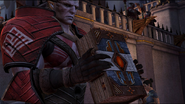The Qunari (literally, "People of the Qun") is the name for the horned race that primarily inhabits northern Thedas, including the island nations of Par Vollen and Seheron, and the settlement of Kont-Aar in northern Rivain. Qunari are very rarely seen in Ferelden, with the exception of some high-class mercenaries (such as the Kadan-Fe). Qunari mercenaries are much more common in the Free Marches.
It is also a term that can refer to a member of any race who adheres to the teachings of the Qun: humans, elves and even dwarves can thus become Qunari. Humans of Rivain and elven slaves of Tevinter are especially susceptible to conversion, although it is not unknown for members of other groups to embrace the Qun.
Those who abandon the Qun are no longer considered to be Qunari. They become Vashoth, "grey ones," though these outcasts prefer the name Tal-Vashoth, "true grey ones." Most Tal-Vashoth are former soldiers and become mercenaries.
Appearance
Qunari are taller and considered to be more physically robust than humans. They have metallic-hued skin (bronze, gold and silver have been observed), white hair, slightly pointed ears, and vivid eyes with colors like violet, red, or yellow.
Most Qunari of both gender have horns though some do not. The horn itself has no nerve endings and can be painlessly removed much like human nails or hair. Once cut off, a horn does not grow back.[1] The horned race's ancient name is "kossith". This term is not widely used or even widely known outside scholarly circles.
Hornlessness
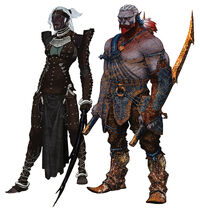
Hornless female and male Qunari[2]
Hornlessness is a rare genetic variation in Qunari, akin to red hair in humans. Those born without horns are considered special and are often given prestigious roles in Qunari society such as a Ben-Hassrath or an envoy to the other races.[3] Sten, who became a companion of the Warden as a soldier of the Beresaad, falls into this category. Culturally, Qunari associate not having horns with being imposing or scary, and because of this Tal-Vashoth often decide to remove their own horns.[4] Likewise, Saarebas, the Qunari mages, have their horns removed to warn of their danger.[5]
Life span
All the races in Thedas are said to live approximately the same length of natural life, but Qunari have developed advanced medicine and sanitation, which allows them to extend their life span to some degree. [6]
History
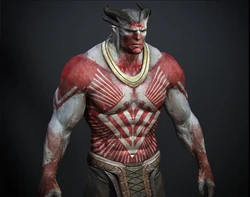
Qunari covered with war paint
A colony of kossith have settled in the southern Korcari Wilds before having been overrun by the darkspawn in the First Blight. It is presumably this colony which led to the darkspawn developing ogres.[7]
The Qunari arrived to Thedas en masse by warships three centuries ago from an unknown eastern land across the Northern Ocean. The contact with it was lost during the Storm Age. They once threatened to conquer all of the known world, but after several Exalted Marches they have lost much land. The Qunari currently maintain a tight grip on Par Vollen and loosely control Seheron. They also hold Kont-Aar in northern Rivain and Qundalon on the coast north of Anderfels.[8] They are involved in a prolonged war for dominance of the north against the Tevinter Imperium.
Timeline:
- 6:30 Steel: The Qunari come to Thedas from across the Northern Ocean and land in Par Vollen. They conquer it quickly, though word of that does not reach the continent.[9]
- 6:32 Steel: The Qunari ships land en masse in Seheron and northern Rivain. The First Qunari War begins and lasts for most of the century.[9]
- By 6:42 Steel: The Qunari have conquered much of the Tevinter Imperium, Rivain, and Antiva and begin to assault the Free Marches. Only Minrathous itself remains besieged but unconquered in the north.[9]
- By 6:85 Steel: Massive rebellions in Tevinter manage to free the Imperium, and the Qunari lines begin to crumble.[9]
- By 7:23 Storm: The Qunari are pushed back to Seheron and Rivain, but they are well entrenched. The Battle of the Nocen Sea is the largest naval engagement in history and results in a stalemate and the destruction of many of the ships on both sides. An impasse begins.[9]
- 7:25–7:85 Storm: The New Exalted Marches are declared repeatedly by both the Imperial Chantry (to retake Seheron and the eastern city of Qarinus) and the Chantry (to retake Rivain). Three major Exalted Marches occur.[9]
- 7:52 Storm: During the second New Exalted March the Qunari recapture much of Antiva.[9]
- 7:54 Storm: The Qunari took the island of Estwatch as a base of operations in their war against the Free March states, Nevarra, and Orlais.
- 7:56 Storm: During the Third New Exalted March The Qunari land a great force in the Free Marches near the city of Ostwick. They try to deny the supplies to the Thedas armies assaulting Rivain: the attack on Starkhaven fails, but Kirkwall is taken in a daring night raid with a heavy use of saarebas' magic.[10]
- 7:60 Storm: Orlesian forces led by Ser Michel Lafaille end the Qunari occupation of Kirkwall.[10]
- 7:78 Storm: The Qunari lose Estwatch to the Felicisima Armada.
- 7:84 Storm: The end of the Third New Exalted March. The Qunari had been pushed back to the city of Kont-Aar in northern Rivain and Par Vollen. Llomerryn Accord is signed and peace is declared between most of the human lands (except for Tevinter) and the Qunari. Skirmishes between Tevinter and the Qunari are few while the Qunari pull back to Par Vollen and rebuild.[9]
- 8:55 Blessed: The Qunari land on Seheron that belongs to Tevinter and conquer it handily within three years. Several attempts to land on the continent and attack Tevinter directly are repulsed.[9]
- 9:31 Dragon: A few hundred[11] Qunari led by the Arishok land in Kirkwall after a shipwreck in a storm.
- 9:34 Dragon: After a series of provocations the Qunari launch a full-scale attack on Kirkwall. They are driven away by the Champion of Kirkwall, Hawke.
The Qun
- Main article: Qun
The Qun is the religion of the Qunari, though it is closer to a philosophy than a full-fledged religion. It governs every part of Qunari life, even the governing structure is dictated by it, and it gives every Qunari a defined and fixed place in their society, either as a soldier (part of the body), as a craftsman (part of the mind) or as a priest (part of the soul).
All followers of the Qun are considered heathens by the Chantry; all converts regarded as heretics, traitors to their teachings and the subjects of prosecution.
Society and culture
The primary symbol used to represent the Qunari as a people is a triangle, which symbolizes the Qunari triumvirate of body, mind, and soul. The "body" is represented by the Arishok (the military), the "mind" by the Arigena (the craftsmen), and the "soul" by the Ariqun (the priests).[12] It is this triumvirate which governs all of Qunari society by acting as the three pillars or their three primary leaders in all matters—the Arishok (always male) who leads the armies, the Arigena (always female) who leads the craftsmen, and the Ariqun (either male or female) who leads the priesthood.[13] All three are the head of their respective "paths" and work in unison to complete the whole of Qunari society.
Duty is paramount in Qunari culture, and their society is seen as a living entity, whose wellbeing is the responsibility of all. Each person is like a drop of blood in the veins of the being, and they must do not what is best for them, but what is best for the creature.
Qunari society is based upon learning as well as military might. Few speak the common tongue that is used among Thedosians, and even fewer speak it well. For this reason, Qunari often keep quiet among foreigners, out of shame—in a culture that strives for perfection and mastery, to possess only a passable degree of skill is humiliating, indeed.
The Qunari do not have a concept of personal identity, and use titles rather than names to identify and present themselves. Their "names" are in fact strings of genealogical information used by the Tamassrans for record-keeping.
A Qunari's personal name is not what we think of as a name. It is more like a social security number, information which the Tamassrans use to keep track of breeding, and is thus not something a Qunari uses to refer to one another. What a Qunari instead thinks of as their name is, in fact, their job title, which is differentiated by rank and task.[14]
Qunari have no "family units": they do not marry, choose partners, or even know to whom they are related. A Qunari's "family" consists of his or her coworkers.[14]
Qunari generally do not associate mating with love. They feel love. They have friends. They form emotional bonds with one another. However, they simply do not sleep with each other to express it. If they do, then they are sent to be reeducated by the Ben-Hassrath. If a child is produced, the same thing happens as with all other Qunari children: it is sent to be raised by the Tamassrans, evaluated, and assigned a job. Qunari do not waste resources unnecessarily, people included.[14]
The Tamassrans wield a great deal of influence in Qunari society. As it is primarily a female gender role (as all administrative tasks are), this might lead an outsider to believe that their society is female-dominated. Qunari do not, however, look upon government in quite the same way. The brain could be said to rule the body, but so too does the heart, the lungs, the stomach. All are part of the greater whole.[14]
The Tamassrans raise all the children, give them their general education, and evaluate them. Qunari are officially assigned their roles at twelve years of age. The Tamassrans do conduct some tests, however nothing requiring a pencil. They also have something of a head start on the process, as they are the ones who control the Qunari selective breeding program.[14]
Qunari believe that the genders are inherently better at certain tasks. No matter how much aptitude a male shows for management, he will never be quite as good at it as a female, therefore it would be considered inefficient to place him in a role where a woman might serve better. Instead, the Tamassrans find another role that he shows aptitude for and place him there instead.[14]
Qunari have been bred for specific roles for a very long time. Parentage is no longer the issue, more like pedigree. However, breeding does not determine a Qunari's assigned task. If a Qunari was bred to be a soldier but turns out to be more intellectual, the Tamassrans may move him into the priesthood, researching weapons technology, or the Ben-Hassrath, policing the populace, depending on what roles need to be filled by someone with their specific traits.[14]
A corpse is considered an insignificant husk that is no longer the individual that it once was and thus is afforded no special treatment, rather disposed of whatever manner is most practical.
Economy
The Qunari reject private property. They also don't have currency, nor do they engage in direct bartering: they don't buy and sell things amongst one another. "Merchants" in Qunari cities have the job of making sure goods are distributed appropriately.[14]
Efficiency is the primary concern in the economy. The Qunari actively work to improve methods of production via research and borrowing from conquered people and neighboring cultures. On the other hand, demands of the individuals are quite limited, as having "more houses and clothes" would mean more work to maintain them.[14] In the countryside, Qunari houses are identical and arranged along perfectly orthogonal lines.[15]
Antaam
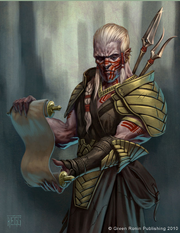
Qunari Beresaad
Antaam, the Qunari army, is lead by the Arishok. The Qunari army is the eyes, ears, legs, arms, and hands of the creature, everything that one needs to interact with the world, and so most Qunari encountered by Theodesians belong to the military.
The Beresaad is the name of the Qunari military division Sten belongs to. According to Sten, the Beresaad serves as "the vanguard of the Qunari people", branching beyond Qunari lands to find answers to the Arishok's questions.
All Qunari are given a tool which signifies their role in Qunari society; for soldiers, this tool is always a weapon of some kind.[14] In the case of soldiers, at least, to lose this weapon brands the owner as soulless and one who is to be executed on sight by the Antaam. These items are held in high regard, and upon the owner's death the Qunari may take the item to honor the fallen individual.
Technology
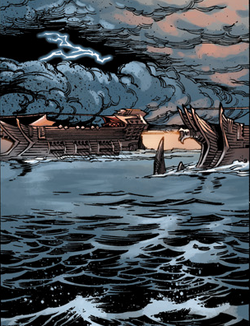
Qunari dreadnoughts (from Those Who Speak)
The Qunari are more technologically advanced than the native Thedosian cultures. Their capital city of Qunandar is famous for great domes and aqueducts.[9] They have developed an explosive powder ("gaatlok") that is more effective than dwarven explosives based on lyrium. Its formula is a secret they carefully guard. The Qunari cannons and dreadnoughts (or "floating fortresses" - massive wooden ships)[16] allowed them to sweep across northern Thedas and advance far into Tevinter within ten years from their arrival on the continent. The allied nations relied heavily on the Circle of Magi to counter their cannons and on the Felicisima Armada to counter their fleet.
Magic
The Qunari call their own mages "saarebas" (a dangerous thing) As the Qunari believe that mages are ultimately unable to master themselves, each saarebas is entrusted to an "arvaarad" (one who holds back evil) who bears a control rod. While some writings claim that the Qunari pity and honor saarebas,[17] they are in fact considered as defective tools[14] threatening everyone around them rather than people. A saarebas is thought to be a part of an arvaarad the same way a sword would be a part of a warrior. Saarebas are treated little better than attack dogs:[18] They are leashed and collared, and their mouths are sewn shut. Should they be found practicing forbidden magic, their tongues are cut out to prevent them from corrupting others.[18][19] The penalty for leaving their karataam is death, as they are assumed to have been corrupted by demons. Lacking proper training, Saarebas are less skilled than Circle mages,[20] which does not preclude the Qunari from usage of saarebas forces in warfare, for instance during the first[10] and the second Qunari invasions of Kirkwall.
Outsiders and converts
The Qunari call outsiders bas (thing) and consider them unfortunate beings who, however, have a potential to grow if the Qun's wisdom is imparted to them.[18] The best an outsider can hope for amongst the Qunari is to be considered basalit-an (an honorable thing). This is a worthy foe, and one that can be negotiated with to an extent, but still bas.[21] The characters which are known to be named with that title are the following:
- The Warden, possibly named by Sten if Sten's approval level is high enough, The Sword of the Beresaad is completed, and The Warden dies killing the Archdemon.
- King Alistair, named by Sten as an Arishok (title) during the events of Those Who Speak.
The Qunari view other nations as inferiors, kabethari (simple ones) who are to be conquered and "enlightened", i.e. converted to the Qun. In the newly subdued areas they dismantle families: children are torn away from their parents and raised as Qunari,[14] while adults are sent to "learning" (labor) camps for re-education performed by a branch of priesthood called the Ben-Hassrath. The latter appear to be reasonable if an individual doesn't resist indoctrination, and a new convert, or viddathari may take a high position in the Qunari society.
Refusal to cooperate is seen as illness to be cured, and those who resist are taken to the viddathlok, temples dedicated to healing. What happens later is not quite clear, but it is known that the Qunari use a substance called qamek to turn them into mindless laborers[22] forced into indentured servitude or sent to mines or construction camps. Some would return, changed in profound ways, some would perish of exhaustion or starvation and some would be slain.
When the Qunari were pushed back during the Exalted Marches, the Chantries tried a purge by the sword, killing Qunari converts and burying them in mass graves, most notably in Rivain[23] and at Nocen Fields and Marnus Pell in Tevinter.[20] These acts were officially denied ever since.
Language
- Main article: Qunlat
Notable Qunari
- For a complete list, see [[::Category:Qunari]].
Trivia
- The Qunari are quite likely based on the Seljuk Turks and the Ottoman Empire, or even the Muslim early conquest period in general.
- They first appear as newcomers (from beyond the in-game Ocean, or from Arabia and Asia in reality) into an already established political scenario (Thedas, or the Mediterranean Sea).
- Both proceed to systematically conquer said lands (early Islam conquered the Levant, Northern Africa, and much of Spain).
- Qunaris are mortal enemies of the Tevinter Imperium, the latter of which has been equated to the Byzantine empire. They possess advanced technology including cannons (like Ottomans). They are considered heathen invaders by the Chantry and have been the target of multiple Exalted Marches, the Chantry's equivalent to a Christian Crusade.
- The Qun and Islam are very similar in the way they often manage to establish themselves smoothly among people recently included into the new rule.
- "Kossith" is an antiquated technical name that is only used by tamassrans to describe the culture that predated the Qun. A few members of the Qunari priesthood may recognize the word, but to everyone in Thedas, they're just "Qunari" or "Tal-Vashoth," respectively.[24][25] Other races sometimes refer to them as "giants" or "ox-men" as well.
- When a female Qunari is turned into a broodmother by darkspawn, she produces ogres.
- A female Qunari is yet to appear in the games of the Dragon Age series, although a concept art exists, and a female tamassran is featured in Dragon Age: Those Who Speak comic series.
- According to Sten, a Qunari warrior believes his sword to be the embodiment of his soul. This is likely a reference to the Samurai of Feudal Japan, who believed that their swords were the physical manifestations of their souls. A Samurai was nothing without his swords, likewise a warrior of the Qunari is nothing without their swords.
- Qunari were always supposed to have horns. They were cut from Dragon Age: Origins, because otherwise Sten would be unable to wear a helmet.[26][27]
- The Qunari have been nicknamed "militant Islamic Borg" by lead writer David Gaider. Gaider later clarified that he meant this as reference to the Qunari's relationship with the other nations of Thedas, not to the specific tenets of Islam.[28]
- The tragic lack of cookies in the Qunari culture is explained by their efficiency: most cultures initially develop cookies and cakes as a way to use up leftover batter from other things. Qunari plan ahead too well to have leftovers.[14]
- In the Qunari society females cannot be soldiers. While Tallis is an assassin who hunts Tal-Vashoth, she is Ben-Hassrath - a religious enforcer and a member of the priesthood (led by the Ariqun) rather than the military (led by the Arishok).
- The structure of the Qunari society is similar to that of the ideal community outlined in Plato's Republic, which divides the population into three classes: Producers (farmers, artisans, laborers, etc.), Auxiliaries (warriors) and Philosophers (rulers). Plato also argued that the interests of the state must always come before individual happiness, rejected private property and stated that children should be raised communally (although the two latter viewpoints were only intended for the ruling class, not the whole society). However, unlike the Qunari, Plato condemned any kind of offensive warfare: the military would exist only to defend.
- Horned Qunari are very similar in appearance to descriptions of the Urgals from Christopher Paolini's series of books, the Inheritance Cycle.
- When Aurelian Titus kills a group of Qunari with a fire spell in Dragon Age: Until We Sleep, Part 2, he implies that the Qunari are somehow related to the dragons. ("Dragonfire. It might have been their birthright. Instead it kills.")
Gallery
See also
- Tales of the Destruction of Thedas, in which a section of the book is dedicated to the Qunari
![]() Codex entry: Par Vollen: The Occupied North
Codex entry: Par Vollen: The Occupied North
Codex entry: The Qunari (Dragon Age II)
![]() Codex entry: The Qunari - Saarebas
Codex entry: The Qunari - Saarebas
![]() Codex entry: History of Kirkwall: Chapter 3
Codex entry: History of Kirkwall: Chapter 3
![]() Codex entry: The Llomerryn Accords
Codex entry: The Llomerryn Accords
![]() Codex entry: Qunari of Other Races
Codex entry: Qunari of Other Races
References
|
| ||||||||||||




